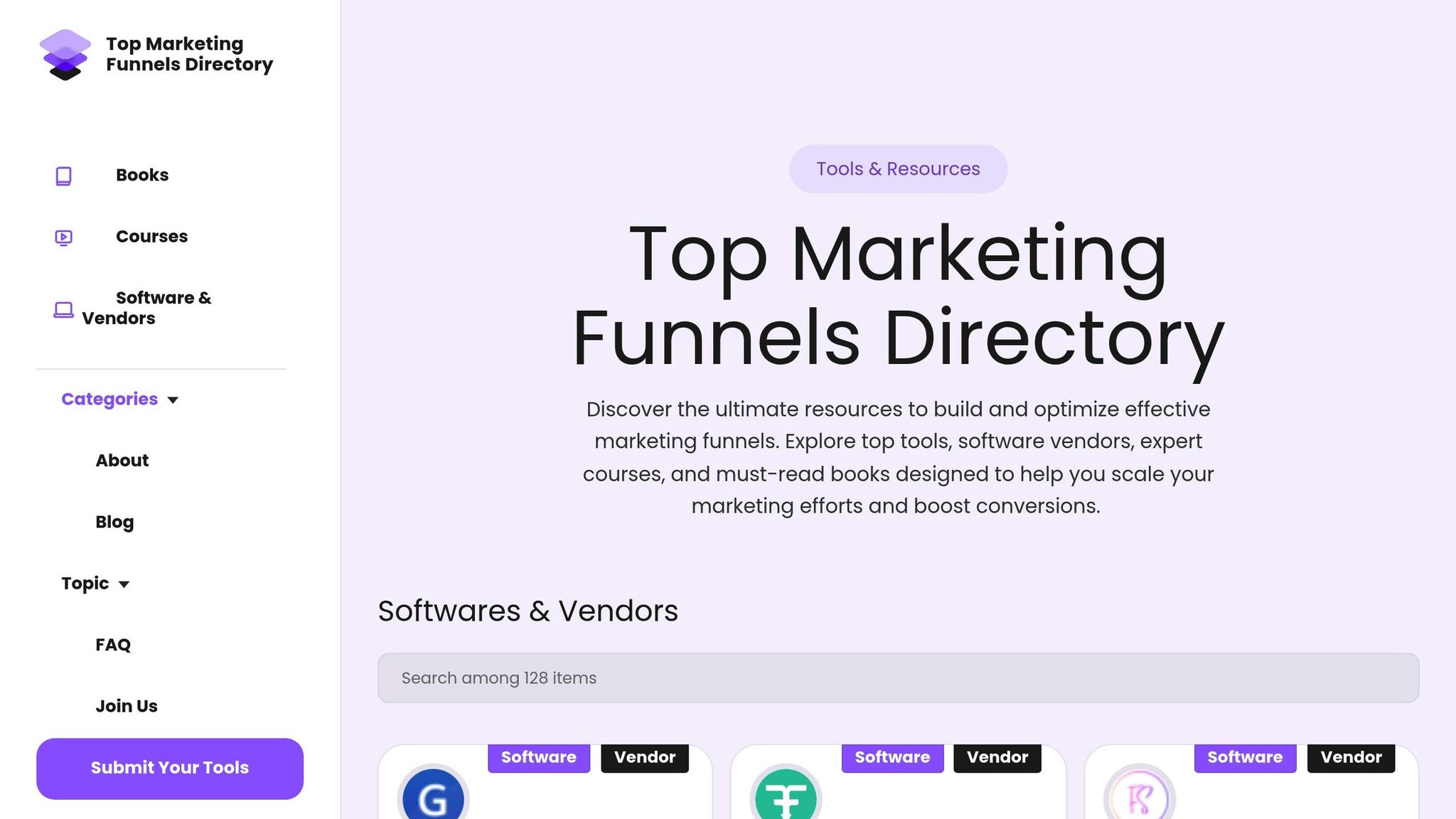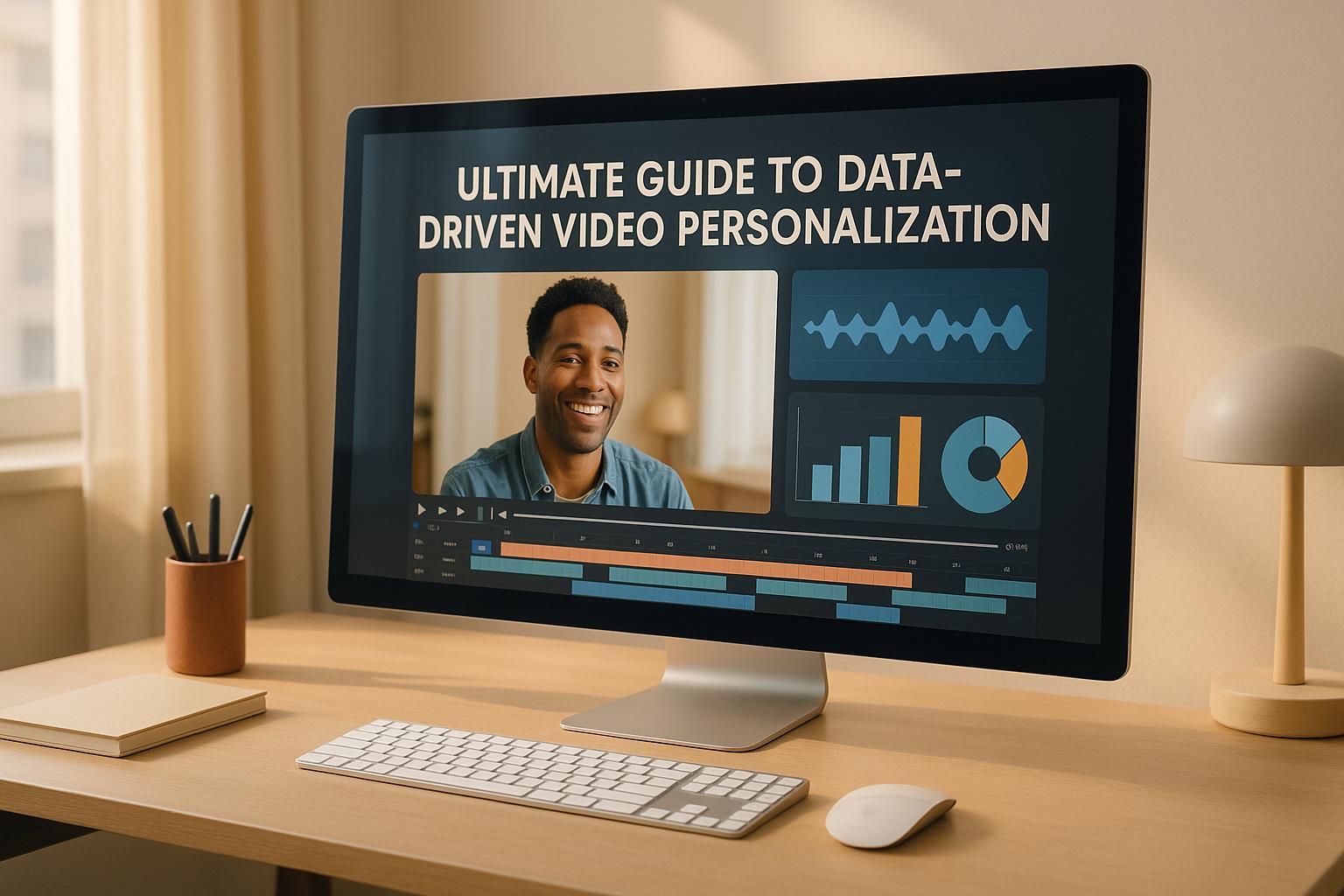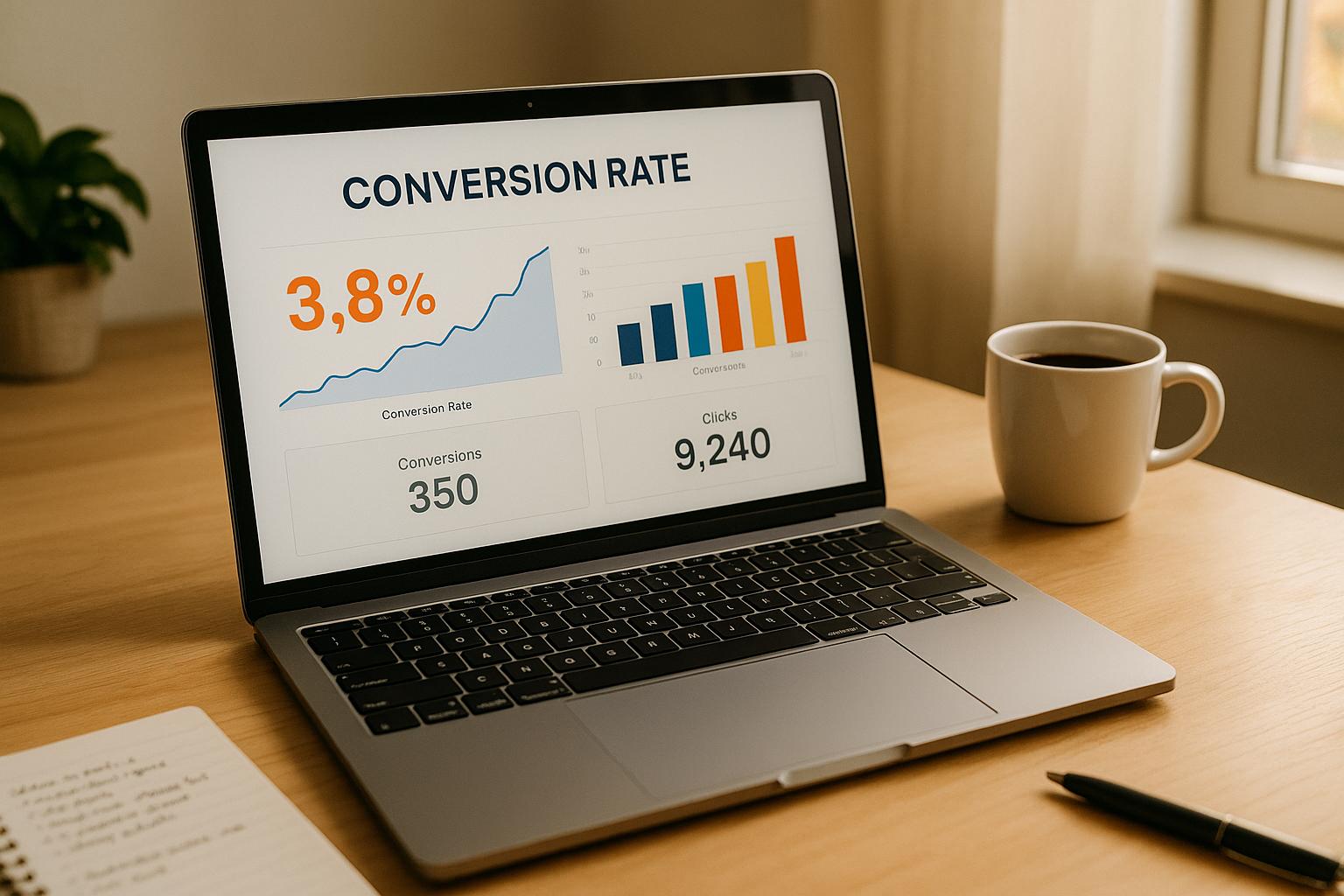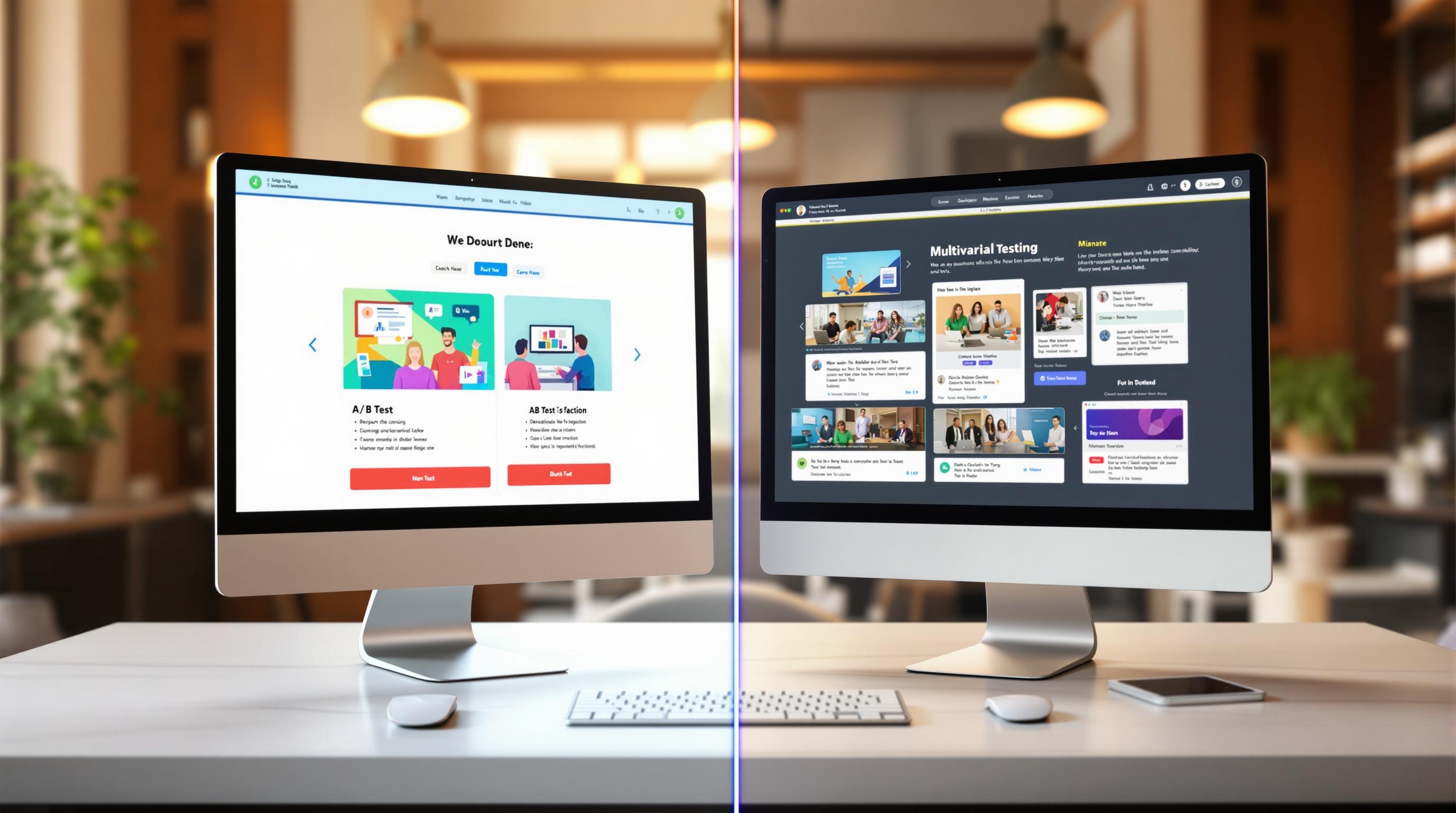Real-time cross-channel reporting helps marketers track customer interactions across platforms instantly. This eliminates delays, enabling quick adjustments and better decision-making. With customers using an average of nine touchpoints before purchasing, this approach ensures no critical data is missed. Businesses leveraging cross-channel strategies report higher revenue growth (9.5% YoY) and better customer retention (89% vs. 33%).
Key takeaways:
- Multi-Touch Attribution: Understand how channels work together to drive conversions.
- Cross-Channel Engagement: Measure audience activity across platforms for a full performance view.
- Conversion Rate & CPA: Identify which channels deliver quality traffic at the best cost.
- Customer Lifetime Value (CLV): Focus on long-term value to optimize marketing spend.
- Funnel Drop-Off Rates: Spot where customers abandon their journey to improve conversion paths.
How to build your cross channel marketing analytics platform within 30 minutes - NO SLIDES
How to Set Up Real-Time Cross-Channel Reporting
Setting up real-time reporting involves integrating data from various marketing platforms and automating processes to create dashboards that deliver instant, actionable insights. Currently, marketers spend over six hours each week analyzing and cleaning data. A well-designed system can drastically cut down this time.
One key step is building a Single Customer View (SCV) to consolidate customer activity across all channels. This unified approach turns scattered data into practical insights, enabling quicker and more informed decisions. Let’s dive into how to connect data sources and create a seamless reporting system.
Connect Data from Multiple Channels
The first step is to identify and catalog all your data sources. These might include social media, email marketing tools, paid ad platforms, CRM systems, or even offline sources like in-store transactions or phone inquiries. Integrating these into a central hub allows for better reporting, segmentation, and personalization.
Start by evaluating each platform or database, assessing the structure and ownership of the data within your organization. This inventory acts as a blueprint for your integration strategy.
Next, decide on an integration method - ETL (Extract, Transform, Load), ELT (Extract, Load, Transform), or CDC (Change Data Capture) - based on the complexity and volume of your data. Once chosen, set up automated synchronization, either through scheduled pipelines or real-time streaming, to ensure stakeholders always have the most current metrics.
Build Custom Dashboards for Real-Time Insights
After integrating your data, the next step is to visualize it effectively. Custom dashboards are essential for turning raw data into insights. A well-designed dashboard should present key information within five seconds, with a recommended limit of 7–9 visualizations to avoid overwhelming users. Each dashboard should serve a specific purpose and allow users to dive deeper into detailed metrics when needed.
For instance, a retail company leveraged a custom dashboard to adjust ad spending during Black Friday, significantly increasing sales.
When designing dashboards, keep your audience in mind. Executives may need high-level KPIs and revenue metrics, while campaign managers might require detailed performance data segmented by channel or audience. Use consistent visual elements like colors and fonts, and include interactive features that allow users to navigate between summary views and detailed breakdowns.
Tools for Real-Time Reporting
Choosing the right tools is critical for a successful reporting setup. For advanced data visualization, platforms like Tableau Creator - priced at around $75 per month - offer robust features, though they might be overkill for smaller businesses. Domo, with its cloud-based AI platform, excels at integrating data sources and delivering quick insights.
For agencies, Whatagraph balances simple setup with powerful customization and multi-client reporting support. If you're already in a Google ecosystem, Looker Studio is a free option, though it may struggle with managing data for multiple clients.
Marketing automation tools like HubSpot (starting at $50 per month) and Klaviyo (free for up to 250 active profiles) are excellent for centralizing data and automating cross-channel touchpoints while capturing analytics.
When selecting a tool, focus on ease of use, scalability, integration options, and security features like data encryption and role-based access controls. Strong customer support is also a must.
With 91% of marketing decision-makers predicting greater reliance on automation by 2025, investing in a real-time cross-channel reporting system is no longer optional - it's a necessity to stay ahead in a competitive landscape.
Checklist: Top Metrics for Real-Time Cross-Channel Reporting
Once your reporting system is live, focus on the metrics that reveal how your campaigns are performing across different channels. These metrics provide the insights you need to make quick, informed adjustments that can amplify your campaign's effectiveness. Each one offers a unique perspective, helping you fine-tune your strategy as you go.
Multi-Touch Attribution Models
Multi-touch attribution (MTA) helps you understand how various channels work together to drive conversions. Instead of attributing all the credit to just the first or last interaction, MTA spreads it across the entire customer journey. This is crucial because most consumers engage with a brand 6 to 20 times before making a purchase.
For example, first-touch attribution credits the initial interaction that brought a customer to your brand, while last-touch attribution focuses on the final step before conversion. However, these single-touch models often overlook the bigger picture.
Weighted models, on the other hand, assign credit based on how much each touchpoint contributes. A linear model might divide credit equally - say 33.33% each to organic social media, email marketing, and Google Shopping. But a data-driven model could reveal that Google Shopping deserves 70%, email marketing 20%, and organic social media just 10%.
Take EcoBio Boutique, for example. By shifting budgets between Facebook and Pinterest based on these insights, they reduced their cost per acquisition (CPA) by 33%, increased their return on ad spend (ROAS) by 55%, and boosted profits by an impressive 311%.
"The key metrics tracked include Customer Acquisition Cost (CAC), Lifetime Value (LTV), Cost Per Click (CPC), Cost Per Acquisition (CPA), and Conversion Rates across all platforms. However, CPA is my priority because keeping acquisition costs low while maximizing top-of-funnel volume is key to sustainable growth."
– Camden Olivero, Owner and Growth Strategist, Niche and Needle Marketing
Once you've properly credited each touchpoint, it's time to measure how engaged your audience is across different platforms.
Cross-Channel Engagement Rate
After attribution, focus on how actively your audience interacts with your content across platforms. The cross-channel engagement rate combines likes, shares, comments, click-throughs, and other actions to give you a comprehensive view of how interested your audience is.
To calculate engagement, divide the total number of actions (likes, shares, clicks, etc.) by your total reach. Analyzing engagement by platform is essential: high engagement on social media might indicate strong brand awareness, while active responses to emails could signal purchase intent.
Marketers using three or more channels in a campaign saw a 494% higher order rate compared to those sticking to just one channel.
Conversion Rate and Cost per Acquisition (CPA)
Your conversion rate shows the percentage of visitors who complete a desired action, whether it’s making a purchase, signing up for a newsletter, or downloading a resource. Tracking this by channel helps you identify which platforms are driving quality traffic.
Meanwhile, Cost per Acquisition (CPA) tells you how much you’re spending to gain each customer. To calculate CPA, divide your total campaign cost by the number of conversions. For instance, if you spend $2,500 on a campaign that brings in 50 customers, your CPA is $50. Monitoring CPA by channel enables you to allocate your budget more effectively without sacrificing reach.
Customer Lifetime Value (CLV)
Customer Lifetime Value (CLV) estimates the total revenue you can expect from a customer throughout their relationship with your brand. It’s calculated by multiplying the average purchase value by purchase frequency and customer lifespan. For example, if a customer spends $100 per purchase, buys twice a year, and stays with your brand for three years, their CLV would be $600.
Comparing CLV across channels can help justify higher acquisition costs for platforms that deliver customers with long-term value. Tracking CLV in real time allows you to spot patterns early and adjust your strategy before it affects profitability.
Funnel Drop-Off Rates and Data Latency
Funnel drop-off rates reveal where customers are abandoning their journey toward conversion. Monitor the percentages of users moving from awareness to consideration, from consideration to intent, and from intent to conversion. This helps you identify the stages that need improvement.
Data latency, or the delay between an event happening and it appearing in your reports, can undermine real-time decision-making. Keeping an eye on data latency ensures the accuracy of your reports.
Omnichannel campaigns that include SMS are 429% more likely to convert, while those with push notifications see a 614% higher order rate.
"A report is only useful if it answers the question: is this marketing actually working?"
– Chris Coussons, Founder, Visionary Marketing
Together, these metrics give you a full view of your cross-channel performance. Each one plays a distinct role, and when combined, they offer a clear picture of how well your marketing efforts are working.
sbb-itb-a84ebc4
How to Use Metrics to Drive Decisions and Optimize Campaigns
Metrics are only as useful as the actions they inspire. Once you've got your metrics checklist in place, it's time to use those insights to fine-tune your campaigns on the fly. By analyzing data and acting quickly, you can turn lackluster campaigns into profitable ones while making the most of your marketing budget.
Find Underperforming Channels
Spotting weak links early is key to reallocating resources effectively. Real-time ad analytics can help you identify struggling ads by tracking core metrics like impressions, click-through rates, and conversions.
Start by comparing incremental ROAS (iROAS) across your channels. Unlike traditional ROAS, which includes all conversions, iROAS focuses on revenue from incremental conversions - those directly driven by your ad spend. Channels with dropping incremental conversion rates or rising effective CPA are clear signs of inefficiency. Comparing performance over different time periods can also show whether a dip in conversions is just a blip or part of a bigger trend.
While traditional KPIs provide a broad overview, they often miss the finer details needed to evaluate individual channels. Instead, focus on metrics that reveal marketing incrementality, efficiency, and true impact. Here's a surprising stat: only 25% of marketers measure incrementality, meaning most rely on inflated ROAS numbers that don't reflect actual performance.
For more precise insights, try A/B testing. In this method, one group sees the campaign while another acts as a control. You can also use geo-experiments or holdout groups to measure incremental revenue. Keep an eye on indirect metrics, too - like spikes in organic search traffic during a campaign - for additional context.
Once you've pinpointed underperforming channels, it's time to make quick, data-informed changes.
Make Data-Driven Adjustments in Real Time
After identifying problem areas, act fast. Real-time metrics allow you to shift budgets to the most effective channels immediately. Increase spending on high-performing channels and cut back on those that aren't delivering results.
For campaigns using real-time bidding, let your data guide bidding strategies and make performance-based adjustments. Regular monitoring and quick tweaks ensure you get the most out of your budget while improving metrics like click-through and conversion rates.
If a campaign isn't hitting its goals, revisit key elements like objectives, audience targeting, content, and channel effectiveness to address issues right away. Real-time A/B testing can also help you identify winning variations quickly. The faster you test and adapt, the sooner you can focus on strategies that work.
Put your budget where it counts - prioritize channels with strong ROI or conversion rates. For struggling channels, dig into cross-channel funnel drop-offs and experiment with combinations like pairing social ads with follow-up emails to boost overall performance.
Match Metrics with Marketing Funnel Stages
When you align your key metrics with each stage of the marketing funnel, your reporting becomes sharper and more actionable. This approach helps you quickly identify areas that are thriving and those that need improvement. By matching the right metrics to each funnel stage, you can uncover bottlenecks, highlight high-performing campaigns, refine your budget allocation, and improve customer experiences.
Mapping metrics to funnel stages also provides clarity on where prospects drop off and where your campaigns excel. The key is knowing which metrics are most relevant at each stage.
Map Metrics to Funnel Stages
Each stage of the funnel serves a unique purpose, requiring specific metrics to measure success. Here’s how to align your tracking efforts with customer behavior at every step:
Awareness Stage (Top of Funnel)
At this stage, the focus is on building visibility and attracting new prospects. Metrics to track include traffic sources (organic, paid, referral), engagement rates, impressions, social media metrics, and bounce rate. These numbers reveal how effectively you’re reaching your target audience through efforts like ad clicks, blog views, or SEO performance.
Consideration Stage (Middle of Funnel)
Here, the goal shifts to nurturing interest and building trust. Metrics such as lead generation rate, lead quality scores, and lead engagement rate are key. Tracking activities like pricing page visits, case study views, and demo requests offers insight into how prospects are evaluating your product or service.
Conversion Stage (Bottom of Funnel)
This is where prospects become paying customers. Focus on conversion rates and customer acquisition costs (CAC). Specific metrics like MQL to PQL conversion rate, PQL to SQL conversion rate, and free trial to paid conversion rate provide a clearer picture of your funnel’s effectiveness. For context, sales funnel landing pages typically see an average conversion rate of 2.35%, with top-performing funnels reaching 5.31% or more.
Retention and Loyalty Stage (Post-Purchase)
This stage measures how well you keep customers engaged over time. Key metrics include customer retention rate, customer satisfaction scores (CSAT), and churn rate. For loyalty, monitor the Net Promoter Score (NPS) and track reviews or recommendations.
| Funnel Stage | Key Metrics to Track |
|---|---|
| Awareness (TOFU) | Traffic, Engagement, Bounce Rate |
| Consideration (MOFU) | Lead Generation Rate, Lead Quality, Engagement |
| Conversion (BOFU) | Conversion Rates, Customer Acquisition Cost (CAC) |
| Retention & Loyalty | Retention Rate, Satisfaction Scores, NPS |
This framework ensures data-driven decisions that improve campaign performance at every stage.
To get the most out of these metrics, segment your audience by factors like demographics, behavior, or geography. This helps you identify trends and variations across campaigns. Additionally, consider external influences like market trends, seasonality, and competitor activity to understand their impact on your performance.
Use Resources from Marketing Funnels Directory

For more precise funnel tracking, the Marketing Funnels Directory offers curated tools, courses, and books tailored to each funnel stage. Whether you’re managing social media campaigns, ad strategies, or B2B lead generation, this directory provides resources to enhance your metrics tracking.
For real-time reporting, the directory focuses on tools designed to align with stage-specific metrics. These resources help you track the customer journey across all channels, ensuring a cohesive approach.
"When you measure how all channels shape the path to purchase, you can build a cross-platform framework to connect with audiences in meaningful ways." - Jason Widup, SVP of Marketing, Pixis
The directory also features courses on attribution modeling, cross-channel optimization, and funnel analysis techniques. This knowledge is critical when deciding how to allocate budgets to the channels and campaigns that drive the best results.
Multi-channel strategies are especially powerful: they can boost conversions by 24% and improve customer retention by up to 91% when customers engage across multiple touchpoints. With access to these resources, you’ll be better equipped to stay ahead in a competitive market.
Conclusion: Key Takeaways for Real-Time Cross-Channel Reporting
Real-time cross-channel reporting is changing the game for customer engagement and revenue growth. By enabling quick, data-driven decisions, it helps keep your campaigns sharp and responsive to market shifts.
The numbers speak for themselves: campaigns using three or more channels see a 287% higher purchase rate, while combining channels like email, in-app, mobile push, and web push can lead to 126X higher sessions per user. These stats highlight the importance of staying agile and optimizing strategies on the fly.
But it’s not just about immediate results. Smarter resource allocation plays a major role in boosting long-term revenue. By focusing your budget on high-performing channels and tactics, you can maximize returns and reduce wasted spend.
Real-time optimization also ensures your efforts are aligned across platforms. With tools to monitor attribution models, engagement rates, and funnel drop-offs, you can quickly adjust campaigns - whether it’s tweaking an email subject line, updating ad creatives, or refining audience targeting.
As Ilse Van Rensburg from Cognism puts it:
"As marketers, it's important to get instant feedback on campaigns so you can change things quickly and increase conversions."
Tracking the right metrics is crucial, especially since 68% of companies fail to monitor proper funnel KPIs, which can hurt conversion rates. By focusing on the right data, you can avoid these common pitfalls and keep your strategy on track.
Cross-channel analytics also helps you cut costs. By aggregating data from multiple platforms, you can make smarter decisions about where to allocate resources, reducing redundant spending and improving collaboration between marketing and sales teams.
For those looking to take things further, the Marketing Funnels Directory offers tools and courses to enhance real-time reporting, attribution modeling, and cross-channel strategies, helping you achieve 5-8x ROI.
To succeed, move beyond manual processes and invest in integrated marketing technologies. Set alerts for key metrics like traffic spikes or conversion drops, and focus on the KPIs that matter most. By doing so, you can shift from a reactive approach to a proactive one, transforming both your marketing funnel and the customer journey.
FAQs
What’s the best way to combine data from multiple channels for real-time cross-channel reporting?
To bring together data from various channels for real-time cross-channel reporting, businesses should rely on centralized tools that merge all data sources into one cohesive system. Eliminating silos and ensuring consistent data is crucial for developing a clear and accurate view of customer interactions.
A Customer Data Platform (CDP) plays a vital role in this process by consolidating data into unified customer profiles. This allows for real-time analysis and smooth tracking across different channels. With this integration, marketers can make smarter decisions, fine-tune campaigns, and ensure consistent experiences for customers across all platforms.
What are the main advantages of using multi-touch attribution models in cross-channel marketing?
Multi-touch attribution models bring several benefits to cross-channel marketing efforts. They give marketers a clearer picture of campaign performance by analyzing how each touchpoint influences the customer journey. This means teams can make better-informed decisions and allocate budgets where they'll have the most impact.
These models also reveal how various channels complement each other, helping businesses fine-tune their strategies to boost ROI and deliver a smoother customer experience. Additionally, they shed light on customer behavior patterns, allowing marketers to adjust their messaging and engagement tactics across all platforms.
What are the best tools for real-time cross-channel reporting, and how do I choose the right one?
Some of the best tools for real-time cross-channel reporting include Google Analytics, Facebook Ads Manager, TikTok Ads, Tableau, Power BI, Looker Studio, and Qlik. These platforms are designed to bring together and analyze data from different marketing channels in one place.
When deciding which tool to use, think about a few key factors: how well it integrates with the platforms you already use, whether it offers real-time data tracking, if it includes automation features to cut down on manual work, and how strong its data visualization capabilities are for delivering clear insights. Picking the right tool can make a big difference in tracking campaign performance and making smarter decisions.


